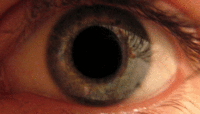
Photo from wikipedia
Objectives The objectives of this study were to test: (1) the repeatability of ultrasonographic examination of the optic nerve sheath diameter (ONSD) in the cat; (2) the association between the… Click to show full abstract
Objectives The objectives of this study were to test: (1) the repeatability of ultrasonographic examination of the optic nerve sheath diameter (ONSD) in the cat; (2) the association between the ONSD and age, sex and body weight in healthy cats; and (3) the difference in the ONSD between healthy cats and those suffering from presumed intracranial hypertension (ICH). Methods This study had a prospective, blinded, observational cross-sectional study design. Two groups of animals were considered: healthy cats (group A) and cats with a diagnosis of presumed ICH (group B). The ONSD was evaluated, measured and compared between the two groups via an ultrasonographic transpalpebral approach. Repeatability of the procedure was evaluated through the intraclass correlation coefficient (ICC). Data were statistically compared using the Student’s t-test and linear regression analysis. Results A strong inter- and intraobserver ICC indicating good repeatability was observed. The interobserver ICC was 0.965 (P <0.05) for the right eye and 0.956 (P <0.05) for the left eye. The intraobserver ICC was 0.988 (P <0.05) and 0.984 (P <0.05) for the right and left eyes, respectively. In healthy cats the mean ± SD ONSD was 1.23 ± 0.11 mm (range 1–1.47 mm) and 1.23 ± 0.10 (range 1–1.4 mm) for right and left eyes, respectively. The ONSD was not related to sex or weight; a weak relationship was observed with age. In group B, the mean ONSD was 1.68 ± 0.13 mm (range 1.5–1.9 mm) and 1.61 ± 0.15 mm (range 1.4–1.9 mm) for the right and left eyes, respectively. In group B, the ONSD was statistically significantly larger than in group A, the healthy cats (P <0.001). Conclusions and relevance The transpalpebral ultrasonographic technique is a non-invasive, feasible and reproducible method to measure ONSD both in healthy cats and in cats suffering from suspected ICH.
Journal Title: Journal of Feline Medicine and Surgery
Year Published: 2020
Link to full text (if available)
Share on Social Media: Sign Up to like & get
recommendations!